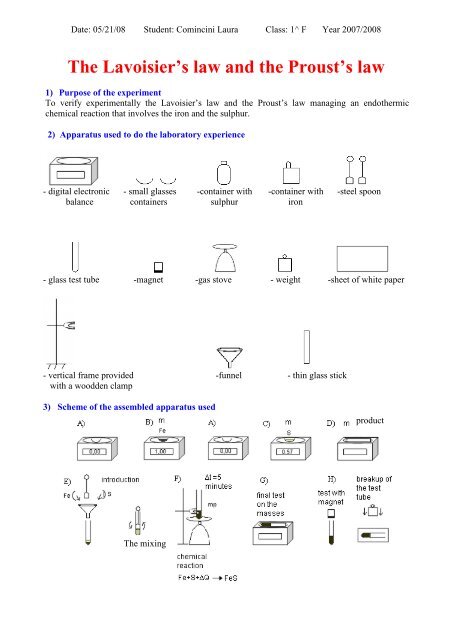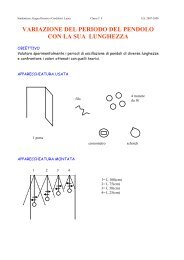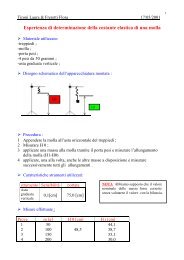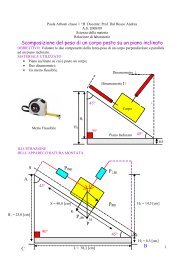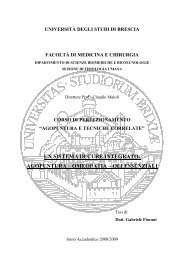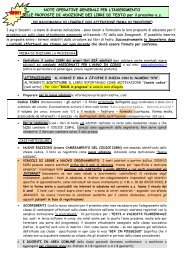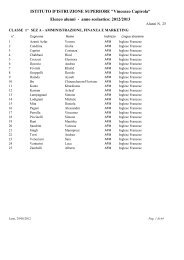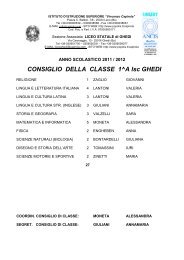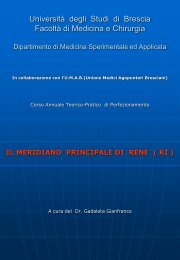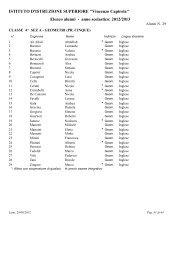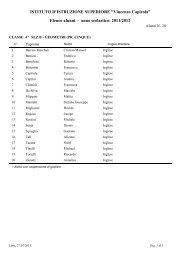Leggi di Lavoisier e di Proust - in inglese - Popolis
Leggi di Lavoisier e di Proust - in inglese - Popolis
Leggi di Lavoisier e di Proust - in inglese - Popolis
You also want an ePaper? Increase the reach of your titles
YUMPU automatically turns print PDFs into web optimized ePapers that Google loves.
Date: 05/21/08 Student: Com<strong>in</strong>c<strong>in</strong>i Laura Class: 1^ F Year 2007/2008The <strong>Lavoisier</strong>’s law and the <strong>Proust</strong>’s law1) Purpose of the experimentTo verify experimentally the <strong>Lavoisier</strong>’s law and the <strong>Proust</strong>’s law manag<strong>in</strong>g an endothermicchemical reaction that <strong>in</strong>volves the iron and the sulphur.2) Apparatus used to do the laboratory experience- <strong>di</strong>gital electronic - small glasses -conta<strong>in</strong>er with -conta<strong>in</strong>er with -steel spoonbalance conta<strong>in</strong>ers sulphur iron- glass test tube -magnet -gas stove - weight -sheet of white paper- vertical frame provided -funnel - th<strong>in</strong> glass stickwith a woodden clamp3) Scheme of the assembled apparatus usedproductThe mix<strong>in</strong>g
4) Brief theoretical premiseThe <strong>Lavoisier</strong>’s law affirms that, dur<strong>in</strong>g a chemical reaction, the mass does not change.m reagent= m products: “noth<strong>in</strong>g is created, noth<strong>in</strong>g is destroied, but only transformed.”The <strong>Proust</strong>’s law states that, when two elements react to form a compound they do it accor<strong>di</strong>ng toa def<strong>in</strong>ed ratio of masses.5) Description of the stages do<strong>in</strong>g the experience1. Phase: to reset the balance (optional);2. Phase: to put the empty small glass conta<strong>in</strong>er on the <strong>di</strong>gital electronic balance A) and to reset it;3. Phase: to value the mass of the iron (1g) on the balance sett<strong>in</strong>g it <strong>in</strong>to the small glass conta<strong>in</strong>erB)4. Phase to repeat the phase 2 with the other small glass conta<strong>in</strong>er A).5. Phase to value the mass of the sulphur (0,57g) C) putt<strong>in</strong>g it <strong>in</strong>to the other small glass conta<strong>in</strong>erplaced on the balance;6. Phase: to weigh the empty test tube D);7. Phase: to put the iron and the sulphur <strong>in</strong>to the test tube us<strong>in</strong>g the funnel and with a th<strong>in</strong> glassstick to mix the mixture <strong>in</strong> order to make it more homogeneous, E);8. Phase: to heat the test tube conta<strong>in</strong><strong>in</strong>g the mixture on the gas stove for about five m<strong>in</strong>utes F);9. Phase: to wait until the chemical reaction occours; later, when the test tube is cooled, take itaway from the gas stove and set it on the balance;10. Phase: to value with the balance the mass of the test-tube conta<strong>in</strong><strong>in</strong>g the ferrous sulphide (FeS)G;)11. Phase: to check if the <strong>Lavoisier</strong>’ law and the <strong>Proust</strong>’s law and have been proved;12. Phase: to prove that the test tube with the FeS is attracted by the magnet H) and to break thetest tube with a weight <strong>in</strong> order to observe the product of the reaction;13. Phase: to gather the data <strong>in</strong> a table;14. Phase: to calculate the percentage error compar<strong>in</strong>g the mass of the reagent with that on of theproduct.6) Physical quantities measuredQuantity Symbol Units Instrumentmass m (g) Digital electronic Balance7) Characteristics of the <strong>in</strong>struments used for the data logg<strong>in</strong>gInstrumentResolution CapacityDigital electronic Balance 0,01(g) 1000(g)8) Gathered dataMFe=y1(g) MS=y2(g) M empty test M test tube E%(M)tube=y3 (g) +FeS(g)= y41,00 0,57 15,92 17,49 0
9) Mathematical formulas used for the work out of the gathered datareagentproductFe A=56 1 mol of Fe=56(g)Eac(M)= y4-(y1+y2+y3)S A=32 1 mol of S=32(g)Erc(M)= Eac(M)/y456/56 (g)Fe+32/56 (g)S=1,57(g) E%c(M)= Erc(M)*1001,00(g)Fe + 0,57(g)S =1,57(g)m=15,92(g) Fe+S m=17,49(g) Fe+S +∆Q m=17,49(g)before the reactionafter the reaction10) F<strong>in</strong>al conclusionAnalysis of the experiment and data <strong>in</strong>terpretation- The E%(M) is null and the reaction had entirely occurred.- at the end of the reaction, the mass of the reagents was equal to the mass of the products so thatthe <strong>Lavoisier</strong>’s law had been confirmed..- breaken the test tube with a weight, the magnet attracted the whole compoud and not only theiron has it happend before the chemical reaction had course. This fact confirms that a newcompound was formed.- We realize also that the <strong>Proust</strong>’s law had been confirmed; the ratio of comb<strong>in</strong>ation of theelements had been R=1/0,57Causes of the errorWe <strong>di</strong>d not have any error concern<strong>in</strong>g the mass, but if we should have any it should be due to thefollow<strong>in</strong>g reason: mass loss because part of it (expecially regar<strong>di</strong>ng the sulphur) may rema<strong>in</strong> stickedto the glass conta<strong>in</strong>er; mov<strong>in</strong>g of the air dur<strong>in</strong>g the weight<strong>in</strong>g with the balance; evaporation of thesulphur dur<strong>in</strong>g the chemical reaction.AdviceFor a better conduction of the experiment <strong>in</strong> order to get less percentage error (concern<strong>in</strong>g the mass)<strong>in</strong> the f<strong>in</strong>al result, it is advisable to make the mixture the most homogeneous as possible; to lead theexperiment <strong>in</strong> a place sheltered by the air; before remov<strong>in</strong>g the test-tube, to put the residues ofsubstances attached to the small glasses conta<strong>in</strong>ers <strong>in</strong>to the test tube itself; to wait until the reactionis completed before remov<strong>in</strong>g the test-tube from the gas stove.Difficulties to cope with do<strong>in</strong>g this experimentNone.Time required to do the experimentAbout 30 m<strong>in</strong>utes.


